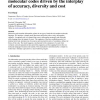Free Online Productivity Tools
i2Speak
i2Symbol
i2OCR
iTex2Img
iWeb2Print
iWeb2Shot
i2Type
iPdf2Split
iPdf2Merge
i2Bopomofo
i2Arabic
i2Style
i2Image
i2PDF
iLatex2Rtf
Sci2ools
CORR
2010
Springer
2010
Springer
A simple model for the evolution of molecular codes driven by the interplay of accuracy, diversity and cost
Molecular codes translate information written in one type of molecule into another molecular language. We introduce a simple model that treats molecular codes as noisy information channels. An optimal code is a channel that conveys information accurately and efficiently while keeping down the impact of errors. The equipoise of the three conflicting needs, for minimal error load, minimal cost of resources and maximal diversity of vocabulary, defines the fitness of the code. The model suggests a mechanism for the emergence of a code when evolution varies the parameters that control this equipoise and the mapping between the two molecular languages becomes non-random. This mechanism is demonstrated by a simple toy model that is formally equivalent to a mean-field Ising magnet.
| Added | 09 Dec 2010 |
| Updated | 09 Dec 2010 |
| Type | Journal |
| Year | 2010 |
| Where | CORR |
| Authors | Tsvi Tlusty |
Comments (0)

